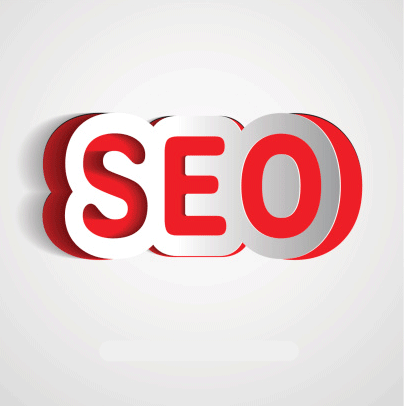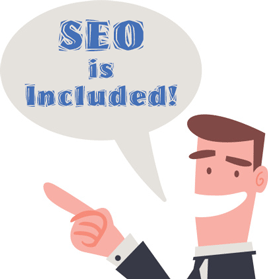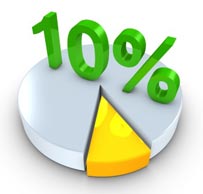
SEO Included – or is it?
“SEO” is a fashionable term among small business website owners. It’s great that they know the acronym for Search Engine Optimization and are smart enough to look for it when purchasing website services, but knowing the acronym is just the tip of the iceberg.
Too many website owners are taken advantage of because they think SEO is a commodity that is the same no matter where they purchase it from -like buying a bundle of firewood from Home Depot or chopping it yourself from a felled tree in your back yard. Wood is wood and when it is burned, it will create heat.
 SEO is not a commodity but more of an art form, so if your web designer or website provider is telling you that “SEO is included,” it’s crucial to understand exactly what they mean when they say “SEO”. More often than not, they are referring to On-Page SEO.
SEO is not a commodity but more of an art form, so if your web designer or website provider is telling you that “SEO is included,” it’s crucial to understand exactly what they mean when they say “SEO”. More often than not, they are referring to On-Page SEO.
On-Page SEO – What they are selling you…
On-page SEO is in the code of your site and that’s why it’s called “on-page”. It’s the process of including your popular search terms within the code of your website so that search engine bots can easily decipher what your website is about.
If you are a marriage counselor in Buffalo, NY, it would be pretty smart to have phrases like the following within the content of your website:
Buffalo marriage counselor
marriage counseling in Buffalo
marriage counselor in Buffalo New York
This type of optimization is usually what providers are including when they tell you that “SEO is Included”.
Where Does On-Page SEO Happen?
WHERE the key phrases appear on your site is just as important as having them on the page in the first place. So where do you put key phrases on your site?
You can watch the video below that I created that explains where on-page SEO happens on your website. It’s just a few minutes long and gives a great overview.
httpvh://www.youtube.com/watch?v=7w3OA9ndBGk
Here are some of the basic elements of SEO:
Title & URL
It’s pretty obvious that your page title is a good place to include your target keyphrases, and many SEO experts would say it’s the most important element of on-page SEO. It’s usually the first place I look to see if someone’s website is SEO optimized.
A website page title shows up in the title bar of the browser window and also typically shows in the search engine listings as the main blue link.


In the code of your site, the title is within the head tags and title tags as shown below
<head>
<title>Marriage Counselor Buffalo, NY - Counselor Name</title>
</head>
Heading Tags (H1, H2, H3)
The heading tags are used to create styled headings throughout your page to highlight different sections of the page. They are basically subtitles on your page and they are an important place to include your targeted search phrases for both human readers and search engine bots.
You can easily spot my headings on this page and in the code of this page in the <h1> tags. The heading at the top of this section will look like this in the HTML code:
<h1>Heading Tags (H1, H2, H3)</h1>
Text Content
It may seem obvious, but your main keywords should also be included in your main text content of your page. Many SEO experts disagree about how many times a key phrase should appear on a page (keyword density). You don’t want to overdo it but your key phrases should be included naturally in the main text.
So the marriage counselor in Buffalo should have “marriage counselor” and “Buffalo” in the main content of the home page and maybe some of the inside pages. There is no magic formula and that’s why on-page SEO is more of an art than a science. The basic take-away here is to make sure your keywords naturally appear in your main content in SOME form and VARIOUS forms.
A Note About Readability…
The three elements of On-Page SEO above are unique because they are seen by both humans and search engines. Google’s #1 priority is your website visitor so the website visitor should be your #1 prioirty as well.
Don’t fall into the practice of writing your pages for search engines by stuffing keywords everywhere creating boring headings made up of just keywords. An over-optimized page is a boring read for a human. The best thing you can do is write your pages for humans and make sure your keywords appear a couple times. Usually that will happen naturally anyway.
Image Names & Tags
A picture is worth a thousand words for your website visitors, and it’s also worth a few words to search engines as well. It’s tempting to save time and ignore the extra steps to optimize your images for your target keywords, but the few extra steps can put you ahead of the competition with your on-page optimization. The two ways to do this are the image file name and the Alt Text.
The file name of the image is the actual name of the file residing on your server. So it may be something like picture.jpg or img124.gif. You can name the file with your keywords, like “marriage-counselor.jpg”. It’s just another place to put your keywords that helps search engines discover what your site is about.
The Alt Tag text is used in case your image cannot be displayed for some reason or for the visually impaired to know what images are being displayed. You want it to be short and descriptive of what the image is, but you can also include your keywords. The code for an image with alt text looks something like this:
<img src="marriage-counselor.gif" alt="Marriage Counseling " />
Internal Linking
Internal linking is one of the most overlooked aspects of SEO. Internal links are the links between the pages of your site. The web is made up of links and while links from other websites are a massive part of OFF-PAGE SEO, having a good internal link structure on your site is also a deciding factor in search engine rankings.
Google and other search engines analyze the internal links on your site to understand what the important pages are on your site and what they are about. Usually the most important pages on a site have a lot of other pages from the same site linking to it.
As an example, if you have a page on your site dedicated to Marriage Counseling, it would be smart to link to it from other pages and include the keyword in or around the link as shown below:
<a href="/marriage-counseling">Marriage Counseling</a>
RESULT: Marriage Counseling
-OR-
Check out our Marriage Counseling page – <a href=”/marriage-counseling”>Click Here</a>
RESULT: Check out our Marriage Counseling page – Click Here
It’s not so important HOW you link to other pages within your site, but just doing it is a major step that many website owners never take. Read this for more tips on good internal linking structure.
On-Page SEO is what you’re paying for – but it’s only 10% of the battle
 What many new website owners don’t realize is that the “SEO” that their website provider is including is On-Page SEO only. If your web designer included On-Page SEO, you can check the elements above when your site is completed to see if they actually did what they promised. But don’t expect your site to rank high in search engines with only On-Page SEO included because On-Page SEO only makes up about 10% of SEO overall. The other 90% is Off-Page SEO.
What many new website owners don’t realize is that the “SEO” that their website provider is including is On-Page SEO only. If your web designer included On-Page SEO, you can check the elements above when your site is completed to see if they actually did what they promised. But don’t expect your site to rank high in search engines with only On-Page SEO included because On-Page SEO only makes up about 10% of SEO overall. The other 90% is Off-Page SEO.
People may argue with me about the percentages, but most would agree that while On-Page SEO is foundational, Off-Page SEO is really what results in rankings in search engines. To understand search engine competition and why Off-Page SEO is important, check out my video here.
It’s time to look at the more important aspect of SEO that is going to influence your search engine rankings and produce meaningful traffic.
All-Important Off-Page SEO
So if I’m saying Off-Page SEO is 90% of SEO, then it’s pretty important and will needs it’s own post or series of posts to do it justice. Make sure to check out my SEO category on my blog and my SEO playlist on Youtube.

 SEO is not a commodity but more of an art form, so if your web designer or website provider is telling you that “SEO is included,” it’s crucial to understand exactly what they mean when they say “SEO”. More often than not, they are referring to On-Page SEO.
SEO is not a commodity but more of an art form, so if your web designer or website provider is telling you that “SEO is included,” it’s crucial to understand exactly what they mean when they say “SEO”. More often than not, they are referring to On-Page SEO. What many new website owners don’t realize is that the “SEO” that their website provider is including is On-Page SEO only. If your web designer included On-Page SEO, you can check the elements above when your site is completed to see if they actually did what they promised. But don’t expect your site to rank high in search engines with only On-Page SEO included because On-Page SEO only makes up about 10% of SEO overall. The other 90% is Off-Page SEO.
What many new website owners don’t realize is that the “SEO” that their website provider is including is On-Page SEO only. If your web designer included On-Page SEO, you can check the elements above when your site is completed to see if they actually did what they promised. But don’t expect your site to rank high in search engines with only On-Page SEO included because On-Page SEO only makes up about 10% of SEO overall. The other 90% is Off-Page SEO.

